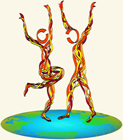
Kim TallBear speaks to “studying across” in contrast to the traditional mode of “studying down,” or even the anti-colonialist turn of “studying up.” For her, this means locating oneself in the overlapping space between the researcher and the object of study. She is personally able to do this by studying indigenous researchers. In doing so, she is able to generate authentic investment in/with her subjects, at the same time she engaged in studying the “colonizers rather than the colonized.” But of course she IS studying the colonized, just not exclusively. Her gaze remains pointed at an indigenous population, but one who has been able to attain object position within the domain of academia.
One thing that interests me about Tallbear’s approach is that she is studying groups with whom she shares membership. Though she doesn’t mention it, this seems to be a defining characteristic of her proposal to “study across.” Without membership, a research cannot help but be “studying down” (or at least “studying at,” depending on their positionality.) Tallbear has the unique position of membership within both a target and agent group (researchers and North American indigenous people). It seems that having this duality represented in project leadership is key to being able to maintain and balance both insider and outsider perspectives. While it might seem ideal in one sense to have dual identity located in one person, it may actually be more powerful to have the identity spread across the group, allowing for greater embodiment, activation, and reflection/dialogue about the relations between these roles both within the research group and between the research group and those they encounter through their study (as long as the leadership group is able to actively address the inevitable power/status dynamics inherited through their respective memberships).
Tallbear alludes to the intertwined leadership of community-based participatory research. In Indigeneity in the Contemporary World: Performance, Politics, Belonging, a project which “explores how indigeneity is expressed and understood in our complex, globalising world,” a level of investment in the target community seems clear, but the level of involvement of the target group is not apparent, aside from the multi-identified members of the research team, many of whom are performers.
To what degree do the staff have dual membership such that they can study across the issue? And with regard to the products of their research (especially the public events) how can readers be invented to “observe across” rather than “observing down”? Given the publication-orientation of research, products and artifacts are distributed beyond their collaborators, and potentially beyond the necessary context to ensure that representations can maintain the sovereignty of their subjects. If we can’t protect their integrity, should we consider not making it such products accessible?
Indigeneity in the Contemporary World: Performance, Politics, Belonging “explores how indigeneity is expressed and understood in our complex, globalising world.”
“As well as developing their own research, core team members host yearly symposia and conference events and will collectively prepare an educational DVD as well as a public exhibition. Visiting research fellows and practitioners have been invited to contribute to the project over the five-year period.”

